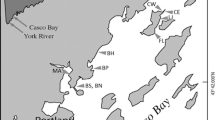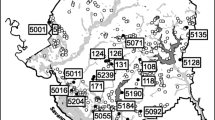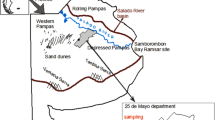Abstract
Water levels fluctuate widely in Carolina bay wetlands and most dry periodically. Aquatic organisms inhabiting these wetlands have the capacity to either resist desiccation or to recolonize newly flooded habitats. The objective of this study was to determine which invertebrates aestivate in the soil of dry Carolina bays and to describe how differences in habitat affect the composition of aestivating invertebrates. Eight Carolina bays located on the Savannah River Site (SRS) near Aiken, South Carolina, USA were examined for this study. Although all of the wetlands dried seasonally, three of the wetlands were relatively wet (inundated 47–92% of the year on average), one was intermediate, and four were relatively dry (inundated 20% of year on average). Sections of soil were removed from each bay during August and November when all sites were dry, placed into tubs, flooded, and covered with fine mesh. Invertebrates were sampled from the water biweekly for four weeks. Invertebrate assemblages were contrasted between naturally inundated bays and rehydrated samples, wetter and drier bays, August and November collections, and remnant ditches and the main basins. Common aestivating fauna included midges, dytiscid beetles, copepods, and cladocerans. The Jaccard’s coefficient of similarity for invertebrates emerging from dry substrate and from naturally flooded wetlands (with both aestivators and colonizers) averaged 0.22. More taxa emerged from rehydrated samples from wetter bays than drier bays. Season affected which taxa emerged. Remnant ditches supported fewer taxa than basins. Aestivating invertebrates make up a significant component of Carolina bya fauna.
Similar content being viewed by others
Literature Cited
Anderson, C. R., B. L. Peckarsky, and S. A. Wissinger. 1999. Tinajas of southeastern Utah: invertebrate reproductive strategies and the habitat template. p. 791–810. In D. P. Batzer, R. B. Rader, and S. A. Wissinger (eds.) Invertebrates in Freshwater Wetlands of North America: Ecology and Management. John Wiley and Sons, New York, NY, USA.
Batzer, D. P., and S. A. Wissinger. 1996. Ecology of insect communities in nontidal wetlands. Annual Review of Entomology 41:75–100.
Broschart, M. R., and R. L. Linder. 1986. Aquatic invertebrates in level ditches and adjacent emergent marsh in a South Dakota wetland. Prairie Naturalist 18:167–168.
Brower J. E., and J. H. Zar. 1977. Field and Laboratory Methods for General Ecology. Wm. C. Brown Company Publishers, Dubuque, IA, USA.
Brown, S. C., K. Smith, and D. Batzer. 1996. Macroin vertebrate responses to wetland restoration in northern New York. Environmental Entomology 26:1016–1024.
Chapman, R. F. 1998. The Insects: Structure and Function. Cambridge University Press, Cambridge, England.
Dietz, S. E. 2001. Variability of invertebrate communities in seasonally flooded, woodland ponds. M.S. Thesis. University of Georgia, Athens, GA, USA.
Dietz, S. E., D. P. Batzer, B. E. Taylor, and A. E. DeBiase. 2001. Invertebrate communities of twenty ditched Carolina bay wetlands scheduled for restoration. p. 321–324. In K. Hatcher (ed.) Proceedings of the 2001 Georgia Water Resources Conference, University of Georgia, Athens, GA, USA.
Edmondson, W. T. (ed.). 1959. Freshwater Biology, second edition. John Wiley and Sons, New York, NY, USA.
Hall, D. L., R. W. Sites, E. B. Fish, T. R. Mollhagen, D. L. Moorhead, and M. R. Willig. 1999. Playas of the Southern High Plains: the macroin vertebrate fauna. p. 635–65. In D. P. Batzer, R. B. Rader, and S. A. Wissinger (eds.) Invertebrates in Freshwater Wetlands of North America: Ecology and Management. John Wiley and Sons, New York, NY, USA.
Jeffries, M. J. 1996. Effects of Notonecta glauca predation on Cyphon larvae (Coleoptera: Scirtidae) populations in small seasonal ponds. Archiy für Hydrobiologie 136:413–420.
Kenk, R. 1949. The animal life of temporary and permanent ponds in southern Michigan. University of Michigan, Museum of Zoology. Miscellaneous Publication 71:4–64.
Kirkman, L. K., R. F. Lide, R. R. Wein, and R. R. Sharitz. 1996. Vegetation changes and use legacies of depression wetlands of the western coastal plain of South Carolina 1951–1992. Wetlands 16:564–576.
Leeper, D. A., and B. E. Taylor. 1998. Insect emergence from a South Carolina (USA) temporary wetland pond, with emphasis on the Chironomidae (Diptera). Journal of the North American Benthological Society 17:54–72.
Medland, V. L., and B. E. Taylor. 2001. Strategies of emergence from diapause for cyclopoid copepods in a temporary pond. Archiv für Hydrobiologie 150:329–349.
Merritt, R. W., and K. W. Cummins. 1996. An Introduction to the Aquatic Insects of North America. Kendall/Hunt Publishing Company, Dubuque, IA, USA.
Pannak, R. W. 1989. Fresh-water Invertebrates of the United States: Protozoa to Mollusca. John Wiley and Sons, Inc., New York, NY, USA.
Schneider, D. W. 1997. Predation and food web structure along a habitat duration gradient. Oecologia 110:567–575.
Schneider, D. W. 1999. Snowmelt ponds in Wisconsin: influence of hydroperiod on invertebrate community structure. p. 299–318. In D. P. Batzer, R. B. Rader, and S. A. Wissinger (eds.) Invertebrates in Freshwater Wetlands of North America: Ecology and Management. John Wiley and Sons, New York, NY, USA.
Schneider, D. W., and T. M. Frost. 1996. Habitat duration and community structure in temporary ponds. Journal of the North American Benthological Society 15:64–86.
Taylor, B. E., G. A. Wyngaard, and D. L. Mahoney. 1990. Hatching of Diaptomus stagnalis eggs from a temporary pond after a prolonged dry period. Archiv für Hydrobiologie 117:271–278.
Taylor, B. E., D. A. Leeper, M. C. McClure, and A. E. DeBiase. 1999. Carolina bays: ecology of aquatic invertebrates and perspectives on conservation. p. 167–196. In D. P. Batzer, R. B. Rader, and S. A. Wissinger (eds.). Invertebrates in Freshwater Wetlands of North America: Ecology and Management. John Wiley and Sons, New York, NY, USA.
Thorp, J. H. and A. P. Covich. 1991. Ecology and Classification of North American Freshwater Invertebrates. Academic Press, Inc., New York, NY, USA.
Wellborn, G. A., D. K. Skelly, and E. E. Werner 1996. Mechanisms creating community structure across a freshwater habitat gradient. Annual Review of Ecology and Systematics 27:337–363.
Wiggins, G. B., R. J. Mackay, and I. M. Smith. 1980. Evolutionary and ecological strategies of animals in annual temporary pools. Archiv für Hydrobiologie Supplement 58:97–206.
Williams, D. D. 1987. The Ecology of Temporary Waters. Croom Helm, Timber Press, Portland, OR, USA.
Williams, D. D. 1996. Environmental constraints in temporary fresh water and their consequences for the insect fauna. Journal of the North American Benthological Society 15:634–650.
Wissinger, S. A. 1999. Ecology of wetland invertebrates: synthesis and applications for conservation and management. p. 1043–86. In D. P. Batzer, R. B. Rader, and S. A. Wissinger (eds.) Invertebrates in Freshwater Wetlands of North America: Ecology and Management. John Wiley and Sons, New York, NY, USA.
Wissinger, S. A., and L. J. Gallagher. 1999. Beaver pond wetlands in northwestern Pennsylvania: modes of colonization and succession after drought. p. 333–62. In D. P. Batzer, R. B. Rader, and S. A. Wissinger (eds.) Invertebrates in Freshwater Wetlands of North America: Ecology and Management. John Wiley and Sons, New York, NY, USA.
Wissinger, S. A., A. J. Bohonak, H. H. Whiteman, and W. S. Brown. 1999. Subalpine wetlands in Colorado: habitat permanence, salamander predation, and invertebrate communities. p. 757–790. In D. P. Batzer, R. B. Rader, and S. A. Wissinger (eds.) Invertebrates in Freshwater Wetlands of North America: Ecology and Management. John Wiley and Sons, New York, NY, USA.
Woodward, B. D., and J. Kiesecker. 1994. Ecological conditions and the notonectid-fairy shrimp interaction. The Southwestern Naturalist 39:160–164.
Wyngaard, G. A., B. E. Taylor, and D. L. Mahoney. 1991. Emergence and dynamics of cyclopoid copepods in an unpredictable environment. Freshwater Biology 25:219–232.
Author information
Authors and Affiliations
Rights and permissions
About this article
Cite this article
Dietz-Brantley, S.E., Taylor, B.E., Batzer, D.P. et al. Invertebrates that aestivate in dry basins of Carolina bay wetlands. Wetlands 22, 767–775 (2002). https://doi.org/10.1672/0277-5212(2002)022[0767:ITAIDB]2.0.CO;2
Received:
Revised:
Issue Date:
DOI: https://doi.org/10.1672/0277-5212(2002)022[0767:ITAIDB]2.0.CO;2




